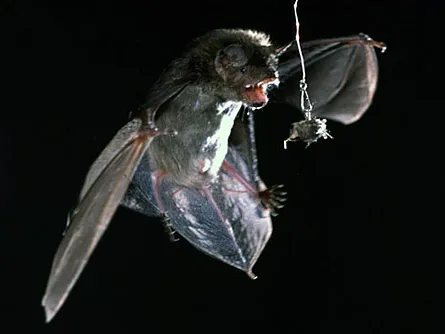A gray moth with orange highlights called Bertholdia trigona “goes berserk,” making lots of noise above the range of human hearing when a hunting bat approaches, says William Conner of Wake Forest University in Winston-Salem, N.C. Bats rely on their natural sonar to locate flying moths in the dark, but in a lab setup, the bats rarely managed to nab a loud moth.

When researchers disabled the moth’s noisemaking organs, though, bats caught the moths in midair with ease, Conner reported at the annual meeting of the Society for Integrative and Comparative Biology.
Conner says the work is “the first example of any prey item that jams biological sonar.”
Conference attendee David Yager of the University of Maryland in College Park says Conner’s experimental paradigm is “very strong, and I do think he has documented jamming by a species of moth.”
Insect-hunting bats and their moth prey have become a classic in the study of evolutionary arms races, Conner says. “This is warfare … The first counter-adaptation is that the insects developed ears.”
Biologists have debated the possibility that moths could also evolve sounds that sabotage bat sonar. “It’s a sexy idea,” Conner said. “There was some tantalizing neurophysiological work.” But to collect behavioral evidence to demonstrate jamming, he said, takes the right moth.
Tiger moths, a group of some 11,000 species, have been intriguing candidates because they present a puzzle in battlefield behavior. As other moth species silently flee when they hear the sonar pings of an incoming bat, tiger moths generally click back. As Conner puts it, “Why would you do that to a bigger, more dangerous predator that’s going to eat you?”
Jamming isn’t the only possible explanation for moth noises, he said. An explosive clicking sound coming back out of the night might startle a bat just a split-second long enough for the moth to get away. Or the moth clicks might work like an acoustic version of the brilliant colors on poison dart frogs, a handy code that helps predators learn and remember that these tidbits are not good to eat.
But three out of four bats in the tests readily ate the moths when the researchers silenced the moth’s sound, so Conner ruled out the possibility that the noise in this species functions mainly as a Mr. Yuk warning.
“Bill’s lab has clearly shown that different species use clicking differently. There’s no single answer to its function,” Yager says. “One of the future challenges will be to discover what ecological and behavioral forces drive one species toward jamming and another toward startle.”
In terms of sound, most tiger moths in North America “crackle a little bit but it’s not very impressive,” Conner says. In contrast B. trigona gives a steady, broad-band sound that “fills up all bandwidth, all the time.”
He first realized these moths made so much noise when he encountered them in the Amazon in 1992, and the possibility that the noise was a sonar jam had been in the back of his mind since, he says. Last summer a field team collected moths in Arizona, the northern tip of the insects’ range, and then one of Conner’s students, Aaron Corcoran, tested them with live big brown bats.
Conner’s research group studies the war between bats and moths by tethering a moth in a large cage and seeing if one of the lab’s resident big brown bats can catch it.






